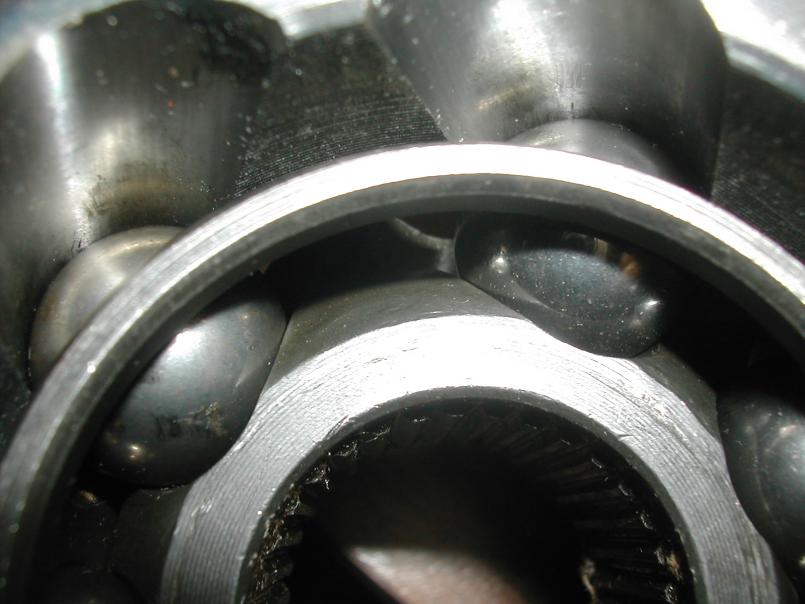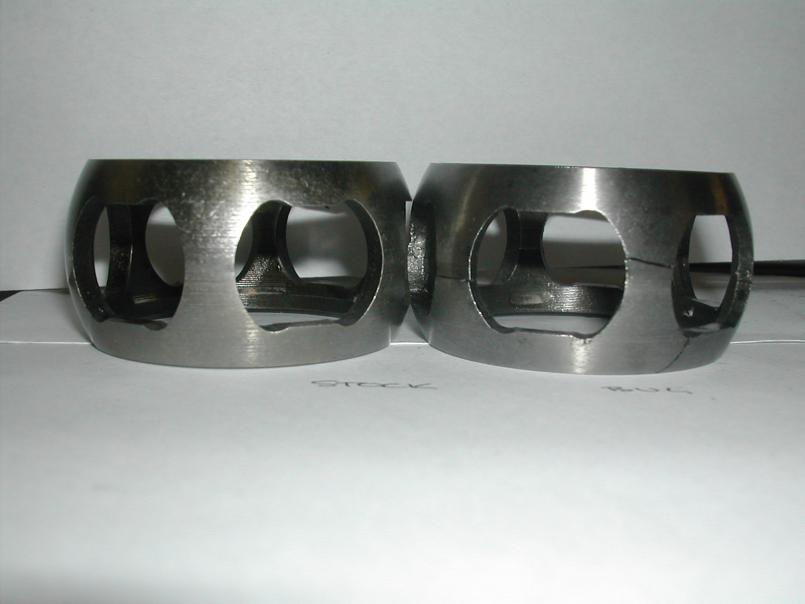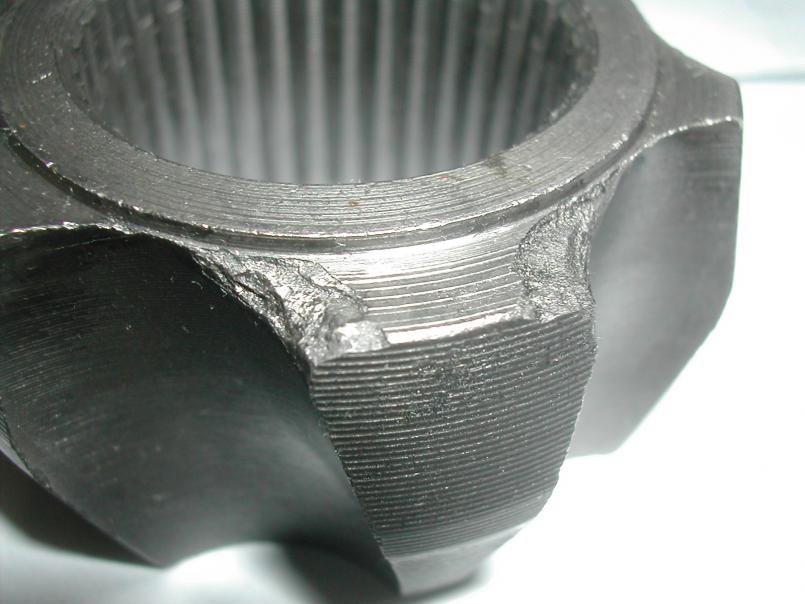JeffBowlsby
Dec 2 2008, 01:28 AM
A few questions...How does a CV fail? Is it progressive or instantaneous? Any warning signs? How many miles does a CV typically last before it fails? When it fails, is it catastrophic? Can it cause an accident if you re at highway speeds or underbody damage? Can our 914s run with just one halfshaft...even temporarily?
I understand stock 914/4 CVs are NLA. What is the best recommended solution?
Got photos of a blown CV?
TIA.

PeeGreen 914
Dec 2 2008, 01:36 AM
On our cars you generally can't hear the warning signs so yes, it will me instant. With you car in gear if you have one wheel in the air and it turns fairly easily it is gone. Look under the car and you can generally see it. I can't think of why it would cause and accident unless it was because of power transfer. Generally happens at stop to start but can happen from more power to the transaxle.
I believe what I have said is true but I'm sure I'll be put in line if not.
914Sixer
Dec 2 2008, 08:08 AM
Listen for a clunking sound on start up and stopping. Sometimes you can feel the vibration in really bad ones.
Gint
Dec 2 2008, 08:09 AM
QUOTE(Jeff Bowlsby @ Dec 2 2008, 12:28 AM)

CV failure?, How can you tell?
Carnogonomo...
Personally I've never had one fail, but I'm curious also.
There are modified Type I CV's available. I think Eric Shea's doin 'em. I think I even bought a full set from him.


So.Cal.914
Dec 2 2008, 08:27 AM
I have had two go. It started as a clicking, progressed as a clunking. I would hear it going around a corner, on takeoff, and then when just cruseing around. The first one let go with a BANG, spitting parts all over. Unless you have a posi you are not going anywhere except on the bed of a tow truck. Your HE's will keep it off the ground but it can bang around above and do damage. I guess it could cause an accident if you freaked out and slammed on the brakes. If you repack the grease in your CV's and keep good dust boots on the they will last a long time if you don't they won't. I think that the load they are under will be a determining factor also as to how long they last. Eric Shea was working on a replacement kit. I believe it is ready. Oh and the second one I had going bad I replaced without incident.
rick 918-S
Dec 2 2008, 08:55 AM

I broke one. I had the boots repacked before WCR 05 trip. The guy at the driveline place told me I had a worn one but I had no time to source one before the trip. So I made it to the gold coast and back. My car was off the road so long I kind of forgot about the weak CV. I never heard anything. No clunk no bucking, no nothing. When the cage shattered the balls trying to push out of the tin cover. The balls actually bent the strap the two bolts go through. One was bent to the point that I couldn't get the bolts out of the CV. I was lucky to be able to remove the bolts. I was also lucky that everything stayed inside the boot.
This is Bills impression of Andy as a photographer.

Eric_Shea
Dec 2 2008, 08:57 AM
The clicking sound Paul describes is probably a broken cage. When this happens you are close to catastrophic failure. They will also howl or moan.
Here is the link to the replacements:
http://www.pmbperformance.com/catalog/item...868/3857681.htmWe now use only “Loebro” replacement CV’s as we have found them to be exact spec to the originals.
Previous to using the Loebro CV’s exclusively, we have had two failures over the last three years. One was McMark and the other was Yarin. Both were replaced under warranty.
Mark was pulling out of a parking lot apron and extending the CV while applying torque. Hardly far from normal so it caused a bit of alarm. It just so happened they were on their way to RRC (I still feel bad about that) which brought them through SLC. While here, Andy and Mark examined the replacement Meyle CV and thought it might extend too far. This was based upon Andy’s knowledge and memory of recently putting together the CV’s for his 5-lug conversion. When Mark arrived back home and examined the broken CV, it looked as though it could have been caused by hyper-extension of the cage. We discussed this in great detail and also looked at the self limiting factors of the stub axles and the transmission flanges. The basic conclusion was that it was “kind of” inconclusive but I think all of us left the subject a little leery of the extra extension found in the Meyle joint.
Yarin was the other CV and it was on a car regularly used for auto-crossing with slicks. In that thread we had another member suggest looking at the Loebro CV’s again (we had both side-by-side originally but Mike Mueller, the original machinist, thought they were basically identical).
All this to say; upon comparing the Loebro against the stock 914 CV and the Meyle I decided to incur the extra $5-6 cost for Loebro kits moving forward. They are more consistent and have the exact extension characteristics as the originals. I am confident that we can bring what was less than a 1% failure rate down even further.
Bruce Hinds
Dec 2 2008, 11:37 AM
I have had a few fail also and didn't hear them getting ready to go. In 23 years, I think I've had 3 and they all were because of abuse. The first in my '73 2.0 was trying to jump out in traffic and one wheel in sand spun up before hitting dry pavement. That one was probably well worn, I had recently aquired the car and was new to the teener.
My other two have been in the V8 car and after diving hard into a tight turn and coming out under lots of power is fun, but it must be done correctly and smoothly. I had gotten on the power too soon with the back end really light, again all that sudden torque on the CVs is a little much for those little cages.
I'm not much on periodic maintanence! So, I'm sure well maintained CV will probably take more.
horizontally-opposed
Dec 2 2008, 11:52 AM
I've heard the clicking at least twice over the years. It's subtle, but not that subtle. And it is load-dependent, going away on a left or right turn but getting loud in the opposite. As it gets worse, it clicks going straight.
This seems to happen well before total failure, because I believe I was able to rebuild them. I seem to remember flat spots on a few of the balls, not cage failure, but memory is failing me 14-16 years later. I think a rebuild, new boots, and new grease did the trick, but maybe I did replace them? They are quiet now.
The other clue: get under your car and keep an eye out for thin grease spray on the underside of the trunk floor, above the CVs. I spotted a split boot this way and repaired it before it became a problem. This is harder to do at the trailing arms, of course.
pete
orange914
Dec 2 2008, 01:51 PM
kennys broke not long after the new motor. now i relize what the "mistery clunk" must have been we were hearing after engine install, we confirmed it wasn't loose mounts. what lead to it's final death is he was driving it and it stalled so he tried to "roll start" it. he and his friend pushed it home because they thought it wouldn't go into gear. the funny thing was it "suposedly" didn't pop AND when you looked at it, it didn't hang down as you might expect. the boot held it in position. it was difficult to "armchair" diagnose them thru it, but they confirmed it by putting it in gear (idle) and watching the shaft spin but no wheel movement.
i guess the 914 doesn't make the same type c.v. "clunk clunk" noise most FWD cars do. from what i've seen it's usually the outer that goes because of the excessive strain when turning
mike
PeeGreen 914
Dec 2 2008, 02:09 PM
So it seems you can hear the clicking noise. I use to work at a shop that specialized in Japanese cars and thewy are easy to diagnose. Never really thought you would be able to hear the clicking since our engines are a bit louder than most and the noise is in the rear. I have six or so laying around the garage so if one breaks I will just put in another until they arte all gone. One they are I wil go to a better CV like a 944 or something like that.
JeffBowlsby
Dec 2 2008, 02:57 PM
This from Wikipedia and gif of a CV (is this what our CVs look like? (I should take one apart I guess):
"Constant velocity joints are usually reliable and largely trouble-free. The two main failures are wear and partial seizure.
Wear in the outer joint usually shows up as vibration at certain speeds, a bit like the vibration caused by an unbalanced wheel. To determine if the joint is worn, a driver should find a big empty parking lot and drive the car slowly in tight circles, left and right. Worn joints will make a rhythmic clicking or cracking noise. Wear in the inner joints shows up as a "clunk" or "pop" when applying power or, if severe, when lifting off the throttle.
Partial seizure causes a strange "pattering" sensation through the suspension. It is caused by the joint overheating, which in turn is usually caused by the outer joint gaiter/boot having split, allowing the joint to throw out its grease. If caught in time, one can clean the joint carefully, repack with grease and replace the gaiter/boot. Kits which include the grease, gaiter/boot, and retaining clips are available from most automotive manufacturers. Some universal gaiters/boots are split lengthwise enabling them to be fitted without having to disassemble the wheel hub and CV joint."
So.Cal.914
Dec 2 2008, 03:36 PM
QUOTE
This from Wikipedia and gif of a CV (is this what our CVs look like? (I should take one apart I guess):
Kind of, with x-ray eyes it would. But it is built inside a cage (Steel round thing).
There was a right up here that showed the correct way to re-assemble them. The pieces have a paticular way they go together.
Joe Ricard
Dec 2 2008, 04:03 PM
I guess I better go change out the clunking CV.
You know I nevr had these problems with stock power.
Damn you Jake Raby. that 2316-210 is tearing the rest of my car apart.
AND I'M HAVING A BLAST DOING IT.
Eric_Shea
Dec 3 2008, 04:01 PM
Here's what they look like inside:

Photo Credit McMark
I'm currently rebuilding 4 911 CV's complete with pics so I'll post them soon, along with my 911 CV, Sway-a-Way axle, 5-lug conversion.
Eric_Shea
Dec 3 2008, 04:09 PM
I just noticed Jeff asked for photos of a blown CV. More photos from Mark's disaster:
Broken Cage:

Broken inner race:

jimtab
Dec 3 2008, 11:02 PM
Both my axles were rebuilt with Eric's CVs and are preforming very well, thanks Eric and McMark.....these guys are the best....keep it in mind. I heard mine go near the end of a "spirited drive" as I rounded the last corner back to my house....when I pulled the axles the CV was toast, broken cage and beat up pieces....I decided to do them all and just get another 140K of stress free driving.
Joe Ricard
Dec 5 2008, 07:08 PM
Got rid of my clunk. Had to go through all my salvaged joints to find a good one.
Turned to the white car and found an almost new one on the passenger outer.
No broken cage just REALLY worn out outer joint and the cage had big wear divots where the balls are riding.
I have 40 pounds of junk.
Time for the purchase of 8 new joints. (2 cars).
JeffBowlsby
Dec 5 2008, 07:25 PM
Can you plese post phoots as a guide to anyone inspecting their joints for wear

ArtechnikA
Dec 5 2008, 08:10 PM
914 CV's have a hard life, the inboards especially, since they sit aft of the engine and directly over the exhaust. Due to the sliding/rolling motion and transmitted torque, proper lubrication is essential and there are very few lubricants that will do the job properly.
LubroMoly makes a moly-disulphide CV joint grease that I trust, and Swepco 101 is at least as good. Personally, I will use no others, although some people have had good results with some other products.
A long while back someone was selling a blue Mobil grease he'd had good results with but I have no personal experience with it - and I sure couldn't tell you the Mobil part number. I do recall that it was an industrial product not packaged for consumer use (i.e. - it came in 50-lb tubs or somesuch...)
All the usual suspects will carry the LubroMoly and/or Swepco 101. Wear gloves; in addition to the general enervating goo-iness of the process, the moly content will want to stain what it touches.
This is not an application for standard wheel bearing grease, not even Mobil-1 synthetic grease which I like for many other applications.
Gint
Dec 5 2008, 11:05 PM
That would have been Dirty Dan's CV Grease. I still have a tub on a shelf in the top of the garage. I used on it a set of CV's that ended up on a 914 that was sold and the car converted to a V8.
Joe Ricard
Dec 6 2008, 06:29 AM
CV's need extreme pressure lubricant.
as well as someting that won't melt from the heat. Molybdinum disulfide is what is in Lubromoly. Good shit. Rags will not wipe it off of anything including hands. (mineral spirits seems to work good to cut it).
Jake Raby
Dec 6 2008, 08:55 PM
One of my R&D Clients owns a CV joint/ half shaft manufacturing facility...
I talked to him on Friday and asked about producing new 914 specific joints, exact replications of the OE units. He said if I created the CAD and bought 100 sets that he'd tool up for them.
He needs some work right now, since he has been providing OE joints for the big 3 for the past few years and the down turn in the economy has impacted him greatly.
I don't know about price yet, but of course its directly related to volume.
This is a "lo-fi" version of our main content. To view the full version with more information, formatting and images, please
click here.


